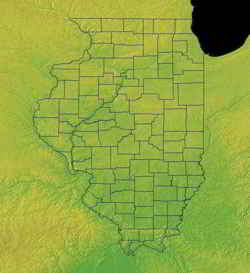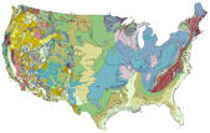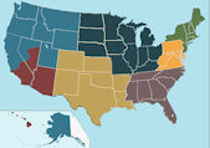Illinois Geography: The Land
Geography and Landforms of Illinois

Find an overview of Illinois geography, topography, geographic land regions, land areas, and major rivers.
Access Illinois almanac, furnishing more details on the state geography, geographical and land regions, climate and weather, elevation, land areas, bordering states, and other statistical data.
Broad, level lands known as the Central Plains, gave Illinois its nickname - the "Prairie State."
The lowest point in Illinois (279 feet above sea level) is found in the Gulf Coastal Plains at the very southern tip of the state. The Ohio and Mississippi Rivers meet here.
The state is divided into three main regions:
- the Central Plains
- the Interior Low Plateaus
- the Gulf Coastal Plains.
Illinois Highest, Lowest, & Mean Elevations |
|
|---|---|
| Mean Elevation | 600 ft. |
| Highest Point | Charles Mound 1,235 ft. |
| Lowest Point | Mississippi River 279 ft. |
Illinois Land Area (Square Miles) |
|
| Geographic Center | In Logan County, 28 mi. NE of Springfield Longitude: 89° 18.4'W Latitude: 40° 0.8'N |
| Total Area | 57,914.38 sq. mi. 25th |
| Land Area | 55,583.58 sq. mi. 95.98% |
| Water Area | 2,330.79 sq. mi. 4.02% |
| Forested Land Area | 12.1% |
| Dimensions (Length - Width) |
390 miles - 210 miles |
Illinois: Physiographic Regions
The landscape of the country can be divided into three major regions:
- the Central Plains, This area is further divided into three sections:
- the Great Lakes Plain,
- the Driftless Plain and the
- Till Plain.
- The Interior Low Plateaus further divided into the
- Shawnee Hills,
- Bluegrass region,
- Western Highland Rim,
- Central Basin,
- Eastern Highland Rim, and
- Tennessee Valley
- Gulf Coastal Plain.
Central Plains
The Central Plains region includes an area of rich farmland known as the Till Plains. These plains are part of the Midwestern Corn Belt, extending from Ohio to Kansas. About 90% of Illinois is covered by the Central Plains region. These gently rolling fertile plains were carved and leveled by glaciers during the Ice Age
Great Lakes Plains - This low flat stretch of land along Lake Michigan develops some small hills north and west of Chicago. The industrial area surrounding Chicago is part of the Great Lakes Plains. Once covered by Lake Michigan, this region has small hills, lakes, and marshes. Illinois has 63 miles of shoreline on Lake Michigan. The Shawnee Hills in the southern part of the state range from 300 to 1,065 feet above sea level. This is an area of forested hills, valleys, woods, and river bluffs.
The Upper Great Lakes Plain covers the southern half of Michigan, northwest Ohio, northern Indiana, northern Illinois, southern Wisconsin, and small portions of southwest Minnesota and northwest Iowa. Glacial moraines and dissected plateaus are characteristic of the topography. Broadleaf forests, oak savannahs, and a variety of prairie communities are the natural vegetation types. A "Driftless Area" was not glaciated during the late Pleistocene and emerged as a unique area of great biological diversity.
The Prairie Peninsula stretches from northeastern Missouri, across much of Illinois and through the middle of Indiana into Ohio. It is a gently rolling glacial plain in the west, but becomes flatter to the east, where prairie and oak openings were embedded in beech-maple forest. Tallgrass prairie, savannah, and forest habitats were interspersed throughout the Prairie Peninsula, although the percentage of prairie declined from west to east. Savannah occurred in transition zones between grasslands and forest, although the extent of savannah varied temporally and spatially with climatic conditions and other ecological influences. Vegetation patterns were influenced primarily by fire, many of which in recent centuries apparently were set by Amerindians.
The Lower Peninsula is fairly level but some low rolling hills can be found in the south. To the north this changes to a northern tableland of hilly belts. The lowest point in Michigan, along the shore of Lake Erie is found in the Lower Peninsula.
The Dissected Till Plains occupy much of Iowa, eastern Nebraska, northwest Missouri, and small parts of northwest Illinois, southern Minnesota, and northeast Kansas. This area was glaciated, uplifted, and subsequently eroded into a flat-to-rolling terrain that slopes gently toward the Missouri and Mississippi River Valleys. Natural vegetation is a mosaic of tallgrass bluestem prairie and oak-hickory forest with oak savannahs characteristic of transition zones. Bottomland hardwoods grow in river valleys.
Interior Low Plateaus
The Interior Low Plateaus constitute a diverse landscape that extends from north Alabama across central Tennessee and Kentucky into southern Illinois, Indiana, and Ohio. It consists of six distinct subregions: the Shawnee Hills, Bluegrass region, Western Highland Rim, Central Basin, Eastern Highland Rim, and Tennessee Valley. Its hilly topography sets it apart from the Coastal Plain to the south and Prairie Peninsula to the north. To the west, the valley of the Mississippi River separates the Interior Low Plateaus from the Ozark Highlands, the two of which share many similarities. Western mesophytic, oak-hickory, and beech-maple forests were historically the most abundant cover types. There were also tallgrass prairie elements in the north and northwest, oak savannahs in the Bluegrass and other northern sections, barrens and glades in central regions, and forested wetlands along major waterways
Gulf Coastal Plains
This is the land between the Ohio River on the east and the Mississippi River on the west and sometimes referred to as "Egypt" because of its resemblance to the Nile Delta.
Mississippi Alluvial Valley - This area includes the floodplain of the Mississippi River that cuts into the Gulf Coastal Plain, extending north to and including the delta at the confluence of the Mississippi and Ohio Rivers and south toward the Gulf of Mexico. The Alluvial Valley includes most of eastern Louisiana, eastern Arkansas, northwest Mississippi, small portions of west Tennessee and Kentucky, the bootheel of Missouri, and the Cache River lowlands of Illinois. Nonforested marsh in southern portions of the floodplain is included in the Coastal Prairie physiographic area. Water shaped this land. The ridges and swales, levees, oxbows, and terraces of the Valley all resulted from meanderings and floods of the Mississippi River. Small changes in elevation determine how wet a site is, the plant community that grows there, and habitat conditions for birds.






